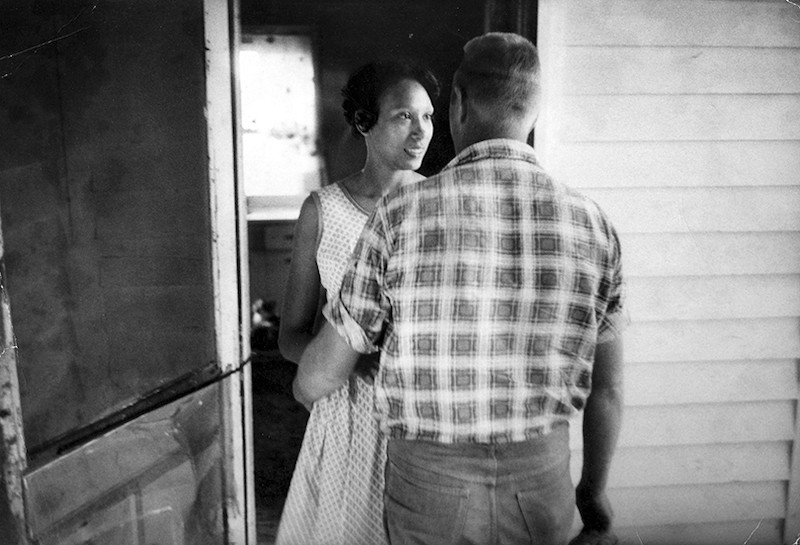
If you wrote an original romantic screenplay called The Loving Story and the main characters were named Mildred and Richard Loving, that’d seem pretty cheesy. But there’s nothing bogus about the “epunymous” title of an incredibly essential documentary focused on the story of the Lovings, an interracial couple whose union in 1958 led to their arrest and conviction and exile from their home state of Virginia. Eventually their case led to the U.S. Supreme Court ruling in favor of mixed-race marriages nationwide, abolishing bans existing at the time in 16 states. The landmark decision took nearly a decade and is one of the most important civil rights triumphs in history. It’s also quite relevant today with the issue of same-sex marriage.
Nancy Buirski’s film doesn’t directly make the link between then and now (though she does in a statement in the film’s press materials), even though Mildred had, until her death, been supportive of gay marriage campaigns and cases referencing herself and Richard via citations of the precedent set forth with Loving v. Virginia. It’s not necessary because we will make the obvious connection ourselves, and it wouldn’t be totally fair to the monumental achievements of half a century ago to impose the parallel. While civil rights histories shall always have unspoken ties to ongoing civil rights struggles, they also have significance of their own without the contemporary context. And The Loving Story is very much a film situated in the past, entirely concerned with the Lovings, their lawyers and what occurred between the moment the couple said, “I do,” and the moment Chief Justice Earl Warren wrote, “Under our Constitution, the freedom to marry, or not marry, a person of another race resides with the individual and cannot be infringed by the State.”
The thing about their name, however, is that it must have carried a kind of felicitous influence that at times made them more like symbols than individuals. As Mildred implies in archive footage early in the film, she and Richard seemed to have been made an example of by authorities, who chose the Lovings over just any other random illegal couple living in the area. Of course, it was also likely beneficial to them and the cause, as far as the perfectness of the name easily attracting media attention. Might the Supreme Court have even picked up their case in part due to the eye-catching name? I know that the combination of title and subject piqued my curiosity as someone who scans through tons of film synopses every day.
Buirski counters the chance of their remaining mere names in the history and law books by filling her documentary with an extraordinary amount of real-time material of the subjects courtesy of never-before-seen verite film shot from 1965 on by Hope Ryden, one of the direct cinema pioneers (she was then a member of Drew Associates, along with such legends as Robert Drew, D.A. Pennebaker, Ricky Leacock, James Lipscomb and Albert Maysles), and cinematographer Abbot Mills. In exceptionally preserved, absolutely beautiful black and white and color footage, we watch the everyday lives of the Lovings and get to hear from them (mostly from the more candid Mildred) while their story plays out. Photographs taken by Grey Villet for a LIFE magazine story on the couple also contribute remarkably towards the transportation of the audience to the era, while audio from the Supreme Court proceedings fill out to fully engross us in the narrative.
Like two other new docs from this year, David France’s How to Survive a Plague and Shola Lynch’s Free Angela Davis and All Political Prisoners, The Loving Story fits into a subgenre that Lynch has coined “historical verite,” films which immerse us in a time through extensive in-the-moment archive material and focused, first-hand storytelling from select interviewees. Buirski’s film does include a number of removed perspectives in the form of expert talking heads, scholars and historians who provide some important background and expository information, though their contributions are hardly as memorable as the original footage and more personally involved reflections. The experts do help with much of Ryden’s film, which captured a lot of footage of the ACLU attorneys who appealed on behalf of the Lovings, yet at the same time they allow the doc to often tip its interests too far on the side of the legal rather than human story.
The film is not called “The Loving v. Virginia Story,” but at the same time if you do prefer a heavy dramatic focus then you might be more interested in the 1996 made-for-TV movie Mr. and Mrs. Loving, which stars Timothy Hutton and Lela Rochon as the couple. Having more affection for the real specific people at the heart (and heart) of this story, especially their determination and courage to disobey their order of exile and live secretly in their home, part of me wished to have simply seen the long-delayed completion of Ryden’s verite film of the events by itself. However, there is a definite necessity to the fuller telling of the history as Buirski has compiled and documented it. With both Mildred and Richard deceased and unable to appear to give their own testimonial presently, the footage from the time is a real blessing and the documentary’s primary cinematic attraction. The rest, though, is occasionally its technical distraction.
The Upside: It’s a civil rights story that needs to be told, and it is told comprehensively. Ryden and Mills’s verite footage is a wonderful gift.
The Downside: The legal stuff dominates the human story, keeping the romantic aspects buried too far beneath the intellectual.
On The Side: The Loving Story previously premiered on HBO and is just now getting an official theatrical release via distributor Icarus Films
Related Topics: documentaries
